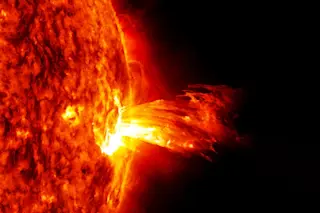Sagittarius A East, an enormous oval shell of gas near our galaxy’s center, has puzzled astronomers since its discovery in 1966. At some 30 light-years across, Sgr A East is about the size of most supernova remnants. Such remnants are produced when an exploding star releases high- energy gases that collide with surrounding interstellar gases, usually with a force of about 1034 tons of TNT. The force of such an enormous explosion typically thrusts gas outward, carving out an immense spherical bubble of empty space. In the more dense medium near the Milky Way’s center, however, a much larger explosion--10 to 100 times a typical supernova--would be necessary to displace the same amount of gas. A single exploding star could not have unleashed the energy needed to create Sgr A East. So how did it form?
Astronomer Alexei Khokhlov at the University of Texas and physicist Fulvio Melia at the University of Arizona now think a huge black hole chomped a star in two some 10,000 to 100,000 years ago, leaving behind the debris we see as Sgr A East.
When astronomers discovered Sgr A East, no one thought that a black hole might be lurking nearby. Since then the trajectories of stars observed near the galactic center have persuaded many researchers that the stars orbit a body of about one million solar masses. Khokhlov and Melia believe that body is a black hole lying within the shell of Sgr A East itself.
A sun-size star approaching within 30 solar radii of the monster, they calculate, would be ripped apart by the black hole’s gravitational pull, which would be far stronger on the near side of the star than on the far side. Half the star would fall into the black hole, but the other half would jet away at about half the speed of light. That jet of outrushing gas would collide with the surrounding interstellar medium with an explosive force, says Khokhlov, of at least 40 supernovas--enough to hollow out the void contained in Sgr A East. The superheated gas would spread out in all directions, eventually surrounding even the black hole. But it would be stretched in the direction of the jet, resulting in an oval shell of gas.
A blast large enough to create a Sgr A East might also have been unleashed by the simultaneous explosion of several dozen supernovas, according to some astronomers. Such a synchronized display of galactic fireworks is pretty unlikely, though, says Khokhlov. We cannot prove that ours is the right explanation, he says, but it looks like the simplest one, and it’s consistent with the clues that there is a black hole there.














